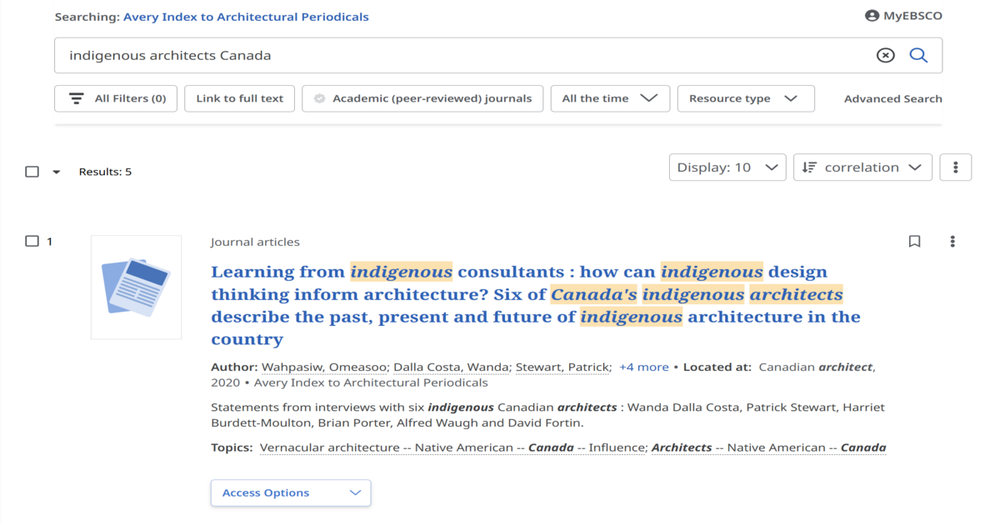Collections Spotlight: Locating Diverse Voices in the Avery Index to Architectural Periodicals

by Barbara Opar, Librarian for Architecture and French Language and Literature
Including diverse voices in architectural design, history and theory research can improve outcomes, providing the researcher with a broader range of results and new possibilities to explore. There is much to learn from other cultures. For example, bamboo is a sustainable building material and can be grown on degraded land. Asian, South American and African countries have long used it as a building material. Vernacular building techniques are now recognized as affording new opportunities. We can learn much about multigenerational living environments from the unique perspectives of those living in co-housing -- something more common in countries outside the United States. What different insights do women designers offer? How have issues of race and ethnicity impacted community planning? Identifying those different voices is essential to form a complete and educated understanding of the issues to consider when designing, teaching or formulating theories about architecture.
That said, how does one go about locating these diverse voices? Unfortunately, for architecture, added research is often needed. The Avery Index to Architectural Periodicals, which remains the premier source for architectural periodical literature, does not include architects’ gender, race, ethnicity or cultural heritage in their indexing.
If the focus of an article is biographical or specificity addresses gender, race or ethnicity, then a relevant subject heading is assigned. Examples include:
- African American/African Americans/African American Architect
- Minority Architects
- Native American
- Race (Concept)
- Vernacular Architecture
For the sake of completeness, however, it is important to research the architect’s specific biography outside the Index or to generate a list of architects who meet the criteria. The following examples clearly depict the difference in both the number of records retrieved as well as the ensuing results.
- Example 1- Learning from Indigenous
- Example 2- Douglas Cardinal
The Avery Index to Architectural Periodicals uses the term Native American and had formerly employed Indians of North America as a subject. A search by a specific name – e.g., Douglas Cardinal—yields 52 records alone for this notable Canadian architect of Indigenous heritage.
- Example 3 - Women Architect -Brazil
- Example 4 - Lina Bo Bardi
There are 52 entries alone for Bo Bardi, far more than for the more general descriptor. The use of architect or architects does not make a difference here as each of the searches yields only 8 results.
- Example 5 - African- American Architects (Note that the dash is necessary for the search.)
- Example 6 - Paul R. Williams
Under African-American Architects there are 184 results.111 items are retrieved by entering the name of the renowned architect, Paul R. Williams. While his full name is Paul Revere Williams, the preferred entry is Paul R. Williams. Searching Paul Revere Williams yields only 12 results. For that reason, when searching, if you are not sure of the appropriate term(s), try alternative ways to enter architects’ names to ascertain the best results. This also applies to keywords like race or ethnicity.
To help locate or determine architects which meet specific criteria, e.g. African-American, consider this source: https://researchguides.library.syr.edu/archselectedtopics. This research guide includes tabs for specific subjects as well as listing the most relevant titles, both general as well as topical. Other notable sources for locating African American architects is African-American Architects by Dreck Spurlock Wilson (NA 736.A7v2004ab), a King + King Architecture Library Reference. This title remains key to the field but does not include significant women architects, especially those working in corporate settings. Susana Torre’s Women in American Architecture (NA 1997 W65, multiple copies) as well as Doris Cole’s 1973 From Tipi to Skyscraper: A History of Women in Architecture (NA 1997.C57 1973, multiple copies) helped establish this field of study and for many years were the only sources available for researching women in architecture. Others have followed, including Anna Sokolina’s Routledge Companion to Women in Architecture (King+King Library Reference NA 1997.R68 2021 and online) and now the soon to be released Bloomsbury Global Encyclopedia of Women, 1960 to 2020, which is being edited by Lori A. Brown from the School of Architecture. Aaron Betsy’s Queer Space (NA2543.H65 B48 1997) was instrumental in bringing this topic to broader audiences. Peter Nabokov and Robert Easton’s Native American Architecture (NA 98.D9 N33 1989, King +King Library monograph) made inroads into introducing Indigenous architects. As noted, a fuller list of titles is included on the research guide.
And, as always, feel to reach out to the Librarian for Architecture (Barbara Opar at baoopar@syr.edu) for further help or suggestions.
To provide feedback or suggest a title to add to the collection, please complete the Resource Feedback Form.
